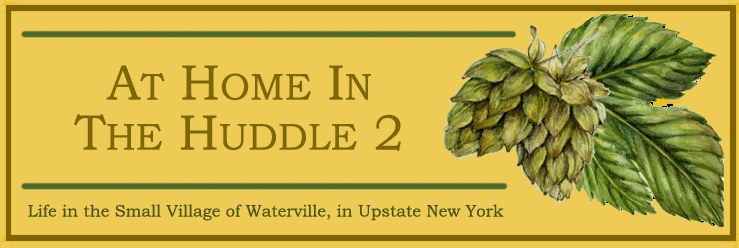It's Recyclables Day!
and
FARMER'S MARKET
56 degrees.
and
FARMER'S MARKET
56 degrees.
- Today: Mostly cloudy with a few patches of drizzle possible. Perhaps a few peeks of sun late. High in the low 70s.
- Tonight: Mostly cloudy with a chance of a spotty t-storm. Low 60.
- Thursday: Mostly cloudy in the morning, but becoming partly sunny with a chance of thunderstorms in the afternoon. Turning slightly more humid. High: 80, Low: 64

**************
Having spent nearly all of yesterday parked at the corner of Elmwood and Putnam, I took no other photographs and barely spoke wih anyone who had anything but "the mill" on their minds. There were lots of questions about the building and the builder: last night I pulled a few things together that I hope will give some answers.

George Putnam was the son of one of Waterville’s early settlers - Nathaniel Putnam. The family lived in a house that was right at the beginning of Putnam Street – in the middle of what is now the road! It had been there since Isaac Terry built it around 1800 and it stayed there until around 1866. That was when George, at age 52, and having become a very prosperous hop farmer, owner of the Putnam Block on Main Street (now Morgan’s Hardware Store and a leader in social and civic affairs of the village, set upon a new venture.
His first goal was to make sure that railway service by the new Utica-Chenango & Susquhanna Valley Railroad came to Waterville. His plan also included establishing a brand new street that would lead from Main Street directly to the railway tracks. That, of course, necessitated the removal of his old home to a new location on Babbott Avenue, where at least parts of it still stand.

Adjacent to the tracks, he would build a warehouse facility of such size that it could also accommodate large community functions in its third-floor auditorium.
 Elegant cast-iron columns flanked the front doorways. The contractors will try to save these for the Historical Society.
Elegant cast-iron columns flanked the front doorways. The contractors will try to save these for the Historical Society.The last brick of his three-story warehouse – Putnam Hall – was set in place in October, 1867 – just about a month before the first railway trains came. One of the largest celebrations to ever take place in Waterville happened on that grand day - November 14, 1867 - thanks to George Putnam.
Between that impressive structure and Main Street, he had building lots surveyed and houses built on them and sold them to the better-off people of the village.
 He kept this Putnam Street home for himself.
He kept this Putnam Street home for himself.The story goes that although the new street was the shortest way to get from Main Street to the warehouse and depot, no workmen were allowed to take that route to their jobs dressed in work clothes and carrying their "lunch pails."
For the next dozen years, Putnam Hall served as a public social center and Waterville’s Opera House. High school graduation exercises took place there. Concerts, recitals and dances were held there, too, and the wealthy - like celebrated artist Albert Bierstadt and his wife Rosalie (Osborn) - gave gala New Year’s Day Oyster Dinners there.
In February, 1879, however, the building was sold to E.W. Buell to become Buell’s Boot and Shoe Factory.

 Hop Bales on the way to the depot in 1904.
Hop Bales on the way to the depot in 1904. Even before then, Waterville had become the major shipping point for this entire area. Riding on one of the wagons was a boy named Fred Zweifel!
This photograph is the only indication of when Buell sold to the Knitting Company. And when asked, recently, a former employee of the knitting mill said that she thought that the mill had finally closed in 1991.
George Putnam died in 1891. His “warehouse” outlived him by 116 years; the Putnam Block along with his “castle” at the corner of Stafford Avenue and Main Street and his fashionable home on Putnam Street still survive as does his “summer place,” the Karram residence on Tower Street, the residence, for many years, of his son and daugher-in-law, Earl and Grace Putnam.
*****************





